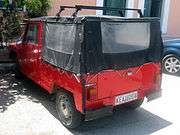Citroën FAF
| Citroën FAF | |
|---|---|
 | |
| Overview | |
| Manufacturer | Citroën |
| Production | 1973-1979 |
| Body and chassis | |
| Class | Supermini |
| Body style | 3-door hatchback |
| Layout | FF layout |
| Related |
Citroën 2CV Citroën Méhari Citroën Dyane Citroën Ami Citroën Bijou |
| Powertrain | |
| Engine | Flat-2 |
| Chronology | |
| Successor | Citroën E-Méhari |
The Citroën FAF is a version of small utility vehicle produced by the French manufacturer Citroën from 1968 until 1987. It was built using a combination of imported and locally sourced components in various developing countries.[1]
The FAF and related vehicles are derived from the 2CV. The concept predates the FAF name, so it is often erroneously reported that some of these vehicles were based on the FAF.[2]
FAF stood for the French Facile à Fabriquer and Facile à Financer (Easy to Manufacture, Easy to Finance). The body was made of easy to produce, folded elements and the car looked effectively like a metallic version of the Méhari.[2] As the name suggests, the flat metal panels and simple components meant to allow "easy" production, mostly in developing countries.[1]
The origin of this idea was the privately built 1963 Baby-Brousse from Ivory Coast.[1] By 1969, Citroën formalized this relationship, and that same year the Vietnamese subsidiary began building La Dalat, the first automobile manufactured in Vietnam.[3][4] Production ended when Americans departed Saigon in 1975 at the end of the Vietnam War, with 5,000 units built.[5]
In 1972, the Greek firm Namco began production of the Pony. This was the most successful version of these 'simplified' 2CV utility vehicles, selling 30,000 units.[6] The Pony was exported as well.[7] Production of this "poor man’s jeep," that benefitted from special tax rules, ended in 1983, two years after Greece joined the European Union. 67% of the parts were of Greek origin.[6]
The idea followed the widespread production of similar 2CV-based vehicles in other countries, including Iran (Jyane-Mehari),[8] Indonesia, Central African Republic, Chile (Yagán),[9][10] Spain, Portugal and others.[1]
The primary target market for the FAF was Africa. However, the concept of a "second-class" car that was connected with the FAF seems to have affected its manufacture and sales that remained low, in contrast to the success enjoyed by some of its predecessors. Various kit car style bodies were also developed, inspired by the FAF and Méhari, such as Belgium's VanClee.
Production history
| Model | 1968 | 1969 | 1970 | 1971 | 1972 | 1973 | 1974 | 1975 | 1976 | 1977 | 1978 | 1979 | 1980 | 1981 | 1982 | 1983 | 1984 | 1985 | 1986 | 1987 | Total |
| Baby Brousse FAF |
495 | 300 | 660 | 2,430 | 2,025 | 1,125 | 2,280 | 4,050 | 1,290 | 2,010 | 3,390 | 5,070 | 3,510 | 2,295 | 1,590 | 600 | None | 30 | None | 30 | 33,180[11] |
References
- 1 2 3 4 Marsh, Julian. "Baby Brousse". Citroënnët. Retrieved 24 April 2017.
- 1 2 Marsh, Julian. "Baby Brousse". Citroënnët. Retrieved 24 April 2017.
- ↑ Ha, Thanh. "La Dalat: Mẫu xe "nội" đầu tiên ở Việt Nam" (in Vietnamese). Giao Thong. Retrieved 24 April 2017.
- ↑ https://vjtadventures.com/citroen-la-dalat-car-vietnam/
- ↑ "Citroën La Dalat: la perle de l’Orient aux origines africaines!" (in French). Boitier Rouge. 8 April 2016. Retrieved 24 April 2017.
- 1 2 "The "poor man’s jeep" is back on the Greek roads". GR Reporter. 10 May 2014. Retrieved 24 April 2017.
- ↑ http://barnfinds.com/1983-namco-pony-citroen/
- ↑ http://automotive-edu.blogspot.com/2015/05/tehran-iran-cafe-racers-celebrate.html
- ↑ http://www.autopasion18.com/HISTORIA-YAGAN.htm
- ↑ http://www.revistaxy.com/ruedas-y-motores/autos/citroen-yagan-el-auto-del-pueblo-chileno/
- ↑ "Production numbers from Citroenet". Citroën statistics. Citroenet.org. Retrieved 6 December 2012.



